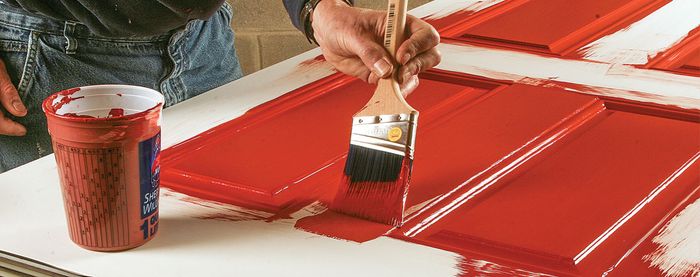How To Stop Paint From Bleeding Under Masking Tape
A super-thin bead of caulk is the secret to a clean edge beween a painted surface and a varnished surface.
If you need to keep a straight, clean line between a painted surface and a varnished surface, you could try free-handing it the way the great painters do, or you could put down some masking tape and hope it doesn’t bleed, but there’s a better way.
This is a tip from Chuck Green from Ashland Massachusetts. And Chuck uses masking tape as well, but he goes one step further to make sure that the masking tape doesn’t bleed through. We’re going to make a mock-up here to show you how it works.
Watch more video tips
Keep Your Truck Tailgate Clear With a Simple Gravel Shield
A How To Hang Drain Lines So They Stay Straight And Secure
Roll Compound On Your Drywall Seams For Faster, Easier Taping
The first thing we do is lay down the masking tape along the edge that we want. Get it in as tight as possible. Then we take this tool that I’ve made up. I usually make a half a dozen of these things whenever I’m on a painting project. They’re wooden chisels with an acute angle on one end that I make out of scraps of hardwood. These things make really great scrapers and putty fillers, but in this case I’m going to use it to press the masking tape down. Having the edge of the masking tape pressed tight to the edge is the really important part. This is going to help keep the paint out, but there’s one more step. So now, the secret sauce is a thin bead of caulk along the edge of the tape where it meets the surface that we’re about to paint. Use the little chisel tool again to force that caulk into the intersection, and to scrape away all of the excess, both on the masking tape and the surface to be painted. The important thing to remember is: don’t use your finger to get a coved layer of caulk in there, because that will make a mess when you go to pull the tape off.
Now you can go ahead and paint. Ordinarily, I would let this dry for a little while, but we’re just going to go ahead and take the tape off now. The caulk hasn’t set up, the paint hasn’t set up, and it will give you a sense of just how clean this edge is.
That’s clean folks. It’s a great tip. Thanks, Chuck. I’ve got to tell you, I just painted my staircase using this method, and it worked to perfection. I appreciate it.






View Comments
If you don't want to clean the brush just hang it in water. You can then continue using it hours later. Of course if it's water based paint it will partially clean it but if oil based it stays fresh for ages.
Everyone knows this!
You can also wrap the brush in a plastic bag and put it in the freezer, it stays ready to use for ages. The same goes for rollers.
this is a cool tip, but if you want to just skip the caulk go with Frog tape. That stuff is amazing when it comes to edges and worth the extra buck. I do still agree that having a tool to press the tapes edge is a necessity Frog tape or regular blue stuff.
We used this tip painting basement walls last month. We wanted a sharp line at the bottom of the walls and I remembered the extra detail of caulk along the edge - it worked great.
These are all great tips. One additional slick tip for clean lines is to press tape firm, then brush a layer of clear shelac against the tape edge to seal the edge. Then paint. Super sharp edges remain.
i'd love to try this next time. looks great, but just before the video cuts to say "now that is clean" the image shows a line of caulk about 1/8 of an inch above the arisse. I think I'd use the damp rag to clean that off.
I'm thinking it won't be so successful with stained or natural wood finishes...
Eric
Here is an alternate to the caulking. Place the masking tape and paint the joint with one coat of clear latex paint, wait for that to dry, then paint the joint.
I do not like the masking tape with caulking idea, as the caulking may change the look of the paint in some cases. I use the plastic tape which is designed for no bleed and crisp lines when needed. I used it when painting multicolor jobs on cars and aircraft.
I have been saving my brushes and rollers that way for years, I figured it out for myself.
This is an amazing tip! I recently bought a packing box full of masking tape so I could do a DIY paint job at home but I never thought that there would be a better way to get everything done. AND I've almost ALWAYS had a problem when it comes to bleeding paint. This is going to make such a difference the next time I start on painting my rooms!